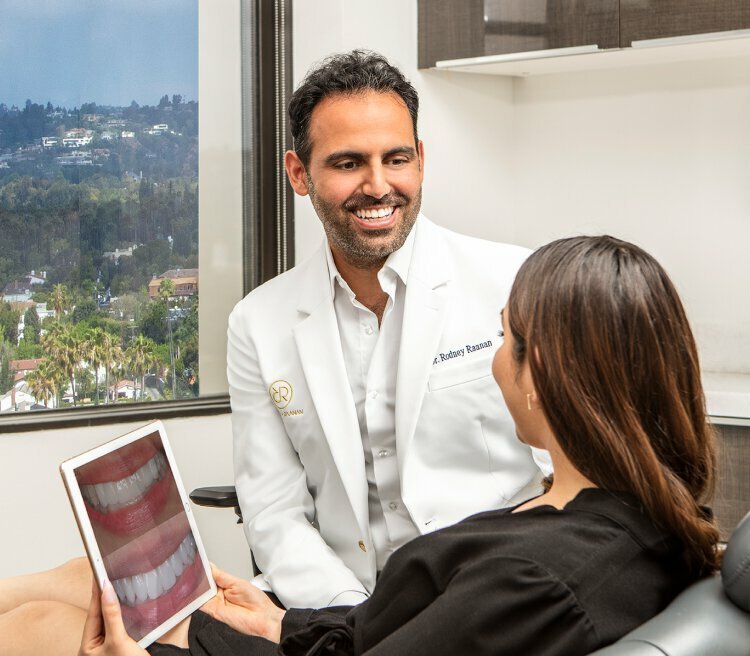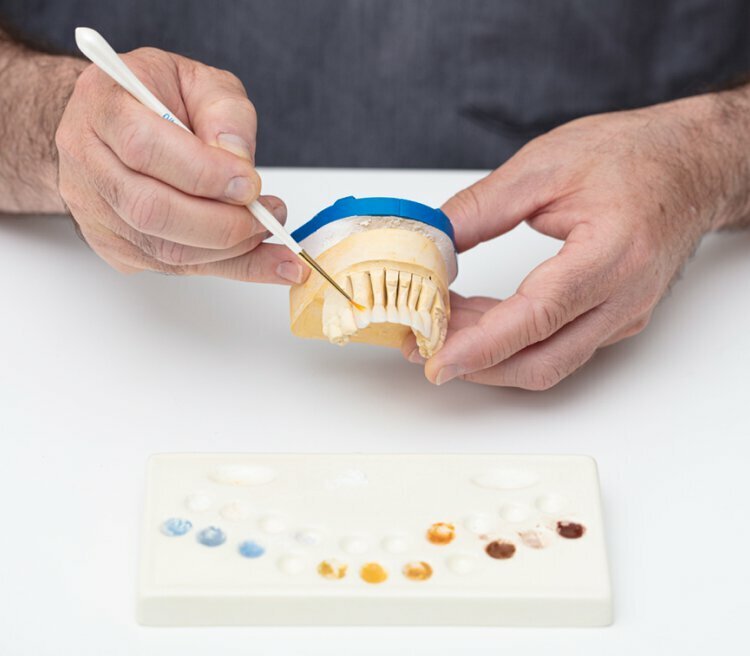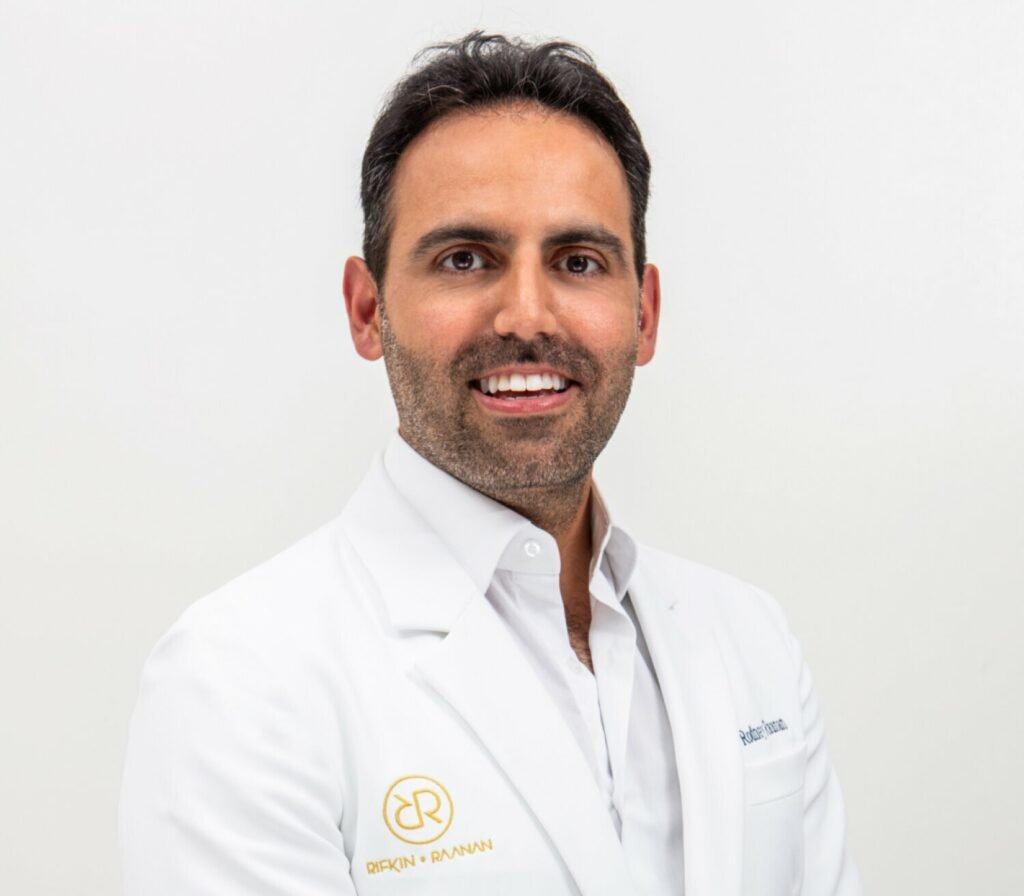Dental Bonding in
Beverly Hills, CA
Dental Bonding in Beverly Hills:
A Simple Way to Enhance Your Smile
At Dr. Rodney Raanan’s practice in Beverly Hills, we understand that even minor imperfections can impact your confidence. That’s why we offer dental bonding, a versatile and minimally invasive cosmetic procedure designed to quickly and effectively enhance the appearance of your teeth. Dental bonding is an excellent solution for subtly transforming your smile, making it brighter, more uniform, and beautifully natural-looking.
As a leading Prosthodontist, Dr. Raanan brings an exceptional level of precision and an artistic eye to every dental bonding procedure. He meticulously sculpts and shapes the bonding material to flawlessly blend with your existing teeth, ensuring results that are not just aesthetically pleasing but also harmonized with your unique smile.
What is Dental Bonding?
Dental bonding is a cosmetic dental procedure that involves applying a tooth-colored composite resin material to your teeth. This durable, plastic-based resin is carefully sculpted by Dr. Raanan to address various aesthetic concerns, then hardened with a special light that bonds the material to the tooth. It’s an excellent, cost-effective alternative to veneers or crowns for correcting minor to moderate dental imperfections.
FEEDBACK FROM OUR PATIENTS
Read The Reviews
Conditions Dental Bonding Can Address
Dental bonding is a remarkably versatile treatment that can effectively improve the appearance of teeth affected by:
- Chipped or Cracked Teeth: Repairing minor chips and cracks to restore a smooth, intact tooth surface.
- Discolored Teeth: Masking stains or discoloration that resist traditional whitening treatments.
- Gaps Between Teeth: Closing small spaces or gaps to create a more uniform smile.
- Misshapen Teeth: Altering the shape of a tooth to make it appear longer, wider, or more symmetrical.
- Exposed Tooth Roots: Covering exposed roots due to gum recession, reducing sensitivity and improving aesthetics.
- Protecting Worn Tooth Structure: Covering areas of teeth that have been exposed due to gum recession.
- As an Alternative to Amalgam Fillings: Used for fillings in front teeth or highly visible areas, offering a more aesthetic, tooth-colored option.
The Benefits of Choosing Dental Bonding
Opting for dental bonding with Dr. Raanan offers numerous advantages:
- Minimally Invasive: Unlike crowns or veneers, dental bonding typically requires very little, if any, removal of your natural tooth enamel. This preserves more of your healthy tooth structure.
- Cost-Effective: It is generally one of the most affordable cosmetic dental procedures, making smile enhancement accessible.
- Quick and Convenient: Most bonding procedures can be completed in a single visit to our Beverly Hills office, usually within 30 minutes to an hour per tooth, depending on the extent of the work.
- Natural Appearance: The composite resin can be perfectly color-matched to your existing teeth, creating a seamless and natural-looking restoration.
- Comfortable Procedure: The process is typically painless and often requires no anesthesia.
The Dental Bonding Procedure with Dr. Rodney Raanan
Getting dental bonding at our Beverly Hills practice is a straightforward and efficient process:
- Preparation: Dr. Raanan will select a shade of composite resin that perfectly matches your natural tooth color. Unlike many other procedures, little preparation of the tooth is needed. In some cases, a small amount of tooth structure might be gently etched to help the bonding material adhere better, but often no enamel removal is necessary.
- Application of Conditioning Liquid: A mild liquid is applied to the tooth surface. This slightly etches the tooth, creating a microscopic rough surface that helps the bonding material bond strongly.
- Application of Composite Resin: The tooth-colored composite resin material is then applied to the tooth. Dr. Raanan will skillfully sculpt and mold the resin into the desired shape, precisely addressing the aesthetic concern.
- Curing: A special high-intensity light (often blue light) is used to harden and bond the resin firmly to the tooth’s surface.
- Finishing Touches: Once hardened, Dr. Raanan will meticulously trim, shape, and polish the bonded material to ensure it looks natural, feels smooth, and harmonizes perfectly with your bite and surrounding teeth.
Dr. Raanan’s meticulous attention to detail ensures that your bonded teeth not only look beautiful but also feel comfortable and function perfectly. If you’re looking for a quick, effective, and beautiful way to improve your smile, dental bonding may be the ideal solution for you. Contact our Beverly Hills office today to schedule a consultation.
Schedule an appointment for the best Porcelain veneers in Beverly Hills
Come in for a consultation and find out all about the best cosmetic dentist in Beverly Hills. Let Dr. Raanan help you Own Your Smile™
By submitting this, you agree to be contacted by us. For more information, [lease read our privacy policy
Dental Crowns in
Beverly Hills, CA
Frequently Asked Questions
Dental bonding is a cosmetic dental procedure that uses a tooth-colored composite resin material to repair or improve the appearance of teeth. This durable plastic-based material is sculpted directly onto the tooth by Dr. Raanan, then hardened with a special light, effectively bonding it to the tooth structure.
Dental bonding is a versatile solution for a variety of minor to moderate aesthetic dental issues. It can effectively repair chipped or cracked teeth, close small gaps between teeth, mask discoloration that doesn’t respond to whitening, change the shape of teeth, and even cover exposed tooth roots due to gum recession.
The longevity of dental bonding can vary, but with proper care and good oral hygiene, it typically lasts between 5 to 10 years. Its lifespan depends on factors such as the location of the bonded tooth (front teeth generally last longer than back teeth subject to heavy biting forces), your biting habits, and how well you maintain your oral health.
One of the great advantages of dental bonding is that it is usually a very comfortable and virtually painless procedure. In most cases, no anesthesia is required, as very little, if any, tooth preparation is needed. You might feel some slight pressure during the application process, but generally, it’s a very straightforward experience.
Dental bonding is known for being a quick and convenient procedure. Most bonding treatments for a single tooth can be completed in just one visit to our Beverly Hills office, usually within 30 minutes to an hour per tooth. This makes it an ideal option for those seeking immediate smile enhancements.
Caring for your bonded teeth is simple and similar to caring for your natural teeth. Maintain a consistent routine of brushing twice a day, flossing daily, and attending your regular dental check-ups and professional cleanings with Dr. Raanan. While the bonding material is durable, it’s wise to avoid biting on hard objects (like ice, hard candies, or pen caps) and to be mindful of consuming highly staining foods and drinks (coffee, tea, red wine) immediately after the procedure, as composite can sometimes stain.
While the bonding material itself is not easily removed without affecting the tooth, the procedure is considered conservative because it involves minimal or no alteration to your natural tooth structure. This makes it a less invasive option compared to veneers or crowns, which require significant enamel removal.







